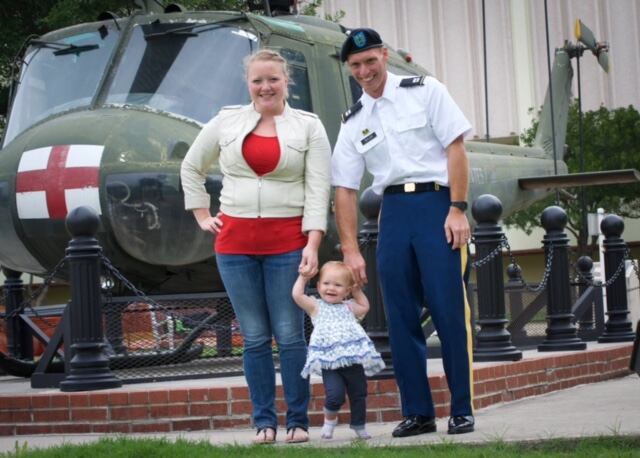Cindy Byler and her husband, Army Capt. Jonas Byler, were facing $60,000 in debt and living paycheck to paycheck in 2013.
In less than three years they were debt-free, except for their mortgage on their former home near Fort Riley, Kansas. They’ve also managed to save $10,000 in an emergency fund. And most of that debt was paid off on a single income, brought in by a junior officer.
“This journey took place over several years,” said Cindy Byler, 25. “It was discouraging at times, and took a lot of sacrifice.”
She can pinpoint the moment the journey truly began: After the birth of their daughter, Eliana, in 2015.
“I was making a decision to become a stay-at-home mom,” leaving her job as a music teacher, Byler said, “and I was just stressed out that we were going to be bringing in $2,300 less a month.”
Her visiting mother-in-law asked, “Where is your money going?’ ”
They realized they really didn’t know.
“I was going to be a stay -at-home mother, our income would be significantly less. There was pressure to get our ducks in a row. We have this baby. We needed to figure this out,” she said.
Eliana’s now 2. Baby David was born in June. The family just made a permanent change-of-station move to Hawaii and didn’t have to tap credit cards to do it — they even used some of the PCS reimbursements to make extra mortgage payments on the house near Fort Riley, which they’re renting out.
DOING THE DEBT MATH
Being debt-free doesn’t mean they’ve stopped their responsible money management. They put about $2,000 to $3,000 in extra each month toward retirement savings and extra mortgage payments.
When they use their credit cards, they pay off the full balance the next month. They’re also saving about $100 a month, for each child, for their education.
About half of their debt — $30,000 — came from Cindy’s college loans. They paid those off Aug. 31, 2016, seven years early.
They also bought a $20,000 car and paid off the loan in February 2016, three years ahead of schedule.
Their $10,000 in credit card debt was accumulated mostly in 2013, with wedding and honeymoon expenses, and a trip to a destination wedding that cost more than the honeymoon. That debt was the first to go — in January 2015.
RELATED

MAKING IT HAPPEN
Taking the reins of this debt-free journey “made me feel like I was contributing financially,” Cindy Byler said, since she wasn’t working full time. “It felt like we were getting a raise when we were doing this program.”
Some moves that have worked for the Bylers:
1. Find a system. The family began following the “Financial Peace” program of Dave Ramsey, a personal money-management expert and national radio personality. They used Ramsey’s “debt snowball” method, targeting their smallest debt first.
They paid as much extra on that debt each month as they could, making minimum payments on the other debts. Once the smallest debt was paid off, they moved to the next debt.
As the red ink dwindled, “we were able to throw over $2,000 each month toward debt, and that’s even with cash-flowing my master’s degree classes,” she said.
2. Speak up. The couple discusses big purchases and always communicates about finances, so money’s never been an issue in the relationship.
“I’m fortunate my husband is an easygoing guy and he’s not materialistic at all,” Cindy Byler said. “But that’s not the case for every relationship, and you need to make sure you’re both on board.”
One contentious issue: He leased a truck at $450 a month in March 2015 against her wishes, she said, after his paid-for 2002 Ford Escort was no longer safe to drive.
3. Shop with a purpose. They plan their meals and stock up at the commissary about 75 percent of the time. When they were living in Texas, they cut their grocery bills in half, down to $240 a month. They’re still sorting out expenses after moving to Hawaii, but expect to spend about $400 to $450 a month on groceries.
4. Know your benefits. Remember that truck? The couple was able to terminate the lease when they moved thanks to the Servicemembers Civil Relief Act. The SCRA also cleared the way for about $300 in refunds of credit card interest and a lower rate (6 percent) on some debt Capt. Byler had before coming onto active duty.
5. Budget, but be flexible. They’re making a new financial plan each month as they settle into the new duty station. They live in housing on base, and the costs are generally covered by their housing allowance, but for other expenses, she budgets $20 a month for clothing; about $100 for gas; and about $50 for miscellaneous.
6. Track, track, track.The Bylers log every dollar they spend through the EveryDollar budgeting app (www.EveryDollar.com). They check what they spend in every category, and the app helps them see what’s left in their budget.
“That brought our debt-free date ahead by literally six months, just knowing exactly where our money was going,” she said.
7. Spend less, care more. Handmade Christmas gifts help save money, and getting rid of debt has enabled them to help others. They recently gave a $250 gift to friends who are expecting twins, and they regularly send money to missionaries in New Zealand.
Being on this financial path “is just freeing,” Byler said. “Especially now that we have our own finances in place, we’re able to be generous. Being able to give to others is huge.”
Karen has covered military families, quality of life and consumer issues for Military Times for more than 30 years, and is co-author of a chapter on media coverage of military families in the book "A Battle Plan for Supporting Military Families." She previously worked for newspapers in Guam, Norfolk, Jacksonville, Fla., and Athens, Ga.




